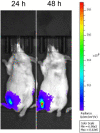A circular mRNA vaccine prototype producing VFLIP-X spike confers a broad neutralization of SARS-CoV-2 variants by mouse sera
- PMID: 35772601
- PMCID: PMC9235288
- DOI: 10.1016/j.antiviral.2022.105370
A circular mRNA vaccine prototype producing VFLIP-X spike confers a broad neutralization of SARS-CoV-2 variants by mouse sera
Abstract
Next-generation COVID-19 vaccines are critical due to the ongoing evolution of SARS-CoV-2 virus and rapid waning duration of the neutralizing antibody response against current vaccines. The mRNA vaccines mRNA-1273 and BNT162b2 were developed using linear transcripts encoding the prefusion-stabilized trimers (S-2P) of the wildtype spike, which have shown a reduced neutralizing activity against the variants of concern B.1.617.2 and B.1.1.529. Recently, a new version of spike trimer, termed VFLIP (five (V) prolines, Flexibly-Linked, Inter-Protomer disulfide) was developed. Based on the original amino acid sequence of the wildtype spike, VFLIP was genetically engineered by using five proline substitutions, a flexible cleavage site amino acid linker, and an inter-protomer disulfide bond. It has been suggested to possess native-like glycosylation, and greater pre-fusion trimeric stability as opposed to S-2P. Here, we report that the spike protein VFLIP-X, containing six rationally substituted amino acids to reflect emerging variants (K417N, L452R, T478K, E484K, N501Y and D614G), offers a promising candidate for a next-generation SARS-CoV-2 vaccine. Mice immunized by a circular mRNA (circRNA) vaccine prototype producing VFLIP-X had detectable neutralizing antibody titers for up to 7 weeks post-boost against SARS-CoV-2 variants of concern (VOCs) and variants of interest (VOIs). In addition, a balance in TH1 and TH2 responses was achieved by immunization with VFLIP-X. Our results indicate that the VFLIP-X delivered by circRNA induces humoral and cellular immune responses, as well as broad neutralizing activity against SARS-CoV-2 variants.
Keywords: SARS-CoV-2; Spike; VFLIP; Vaccine.
Copyright © 2022 Elsevier B.V. All rights reserved.
Conflict of interest statement
We wish to confirm that there are no known conflicts of interest associated with this publication and there has been no significant financial support for this work that could have influenced its outcome.
Figures








Similar articles
-
A Modified Recombinant DNA-Based SARS-CoV-2 Vaccine Expressing Stabilized Uncleavable Spike Protein Elicits Humoral and Cellular Immunity against Various SARS-CoV-2 Variants of Concern.Transbound Emerg Dis. 2023 Dec 11;2023:5279979. doi: 10.1155/2023/5279979. eCollection 2023. Transbound Emerg Dis. 2023. PMID: 40303691 Free PMC article.
-
The E484K Substitution in a SARS-CoV-2 Spike Protein Subunit Vaccine Resulted in Limited Cross-Reactive Neutralizing Antibody Responses in Mice.Viruses. 2022 Apr 21;14(5):854. doi: 10.3390/v14050854. Viruses. 2022. PMID: 35632595 Free PMC article.
-
SARS-CoV-2 prefusion spike protein stabilized by six rather than two prolines is more potent for inducing antibodies that neutralize viral variants of concern.Proc Natl Acad Sci U S A. 2022 Aug 30;119(35):e2110105119. doi: 10.1073/pnas.2110105119. Epub 2022 Aug 22. Proc Natl Acad Sci U S A. 2022. PMID: 35994646 Free PMC article.
-
Transchromosomic bovines-derived broadly neutralizing antibodies as potent biotherapeutics to counter important emerging viral pathogens with a special focus on SARS-CoV-2, MERS-CoV, Ebola, Zika, HIV-1, and influenza A virus.J Med Virol. 2022 Oct;94(10):4599-4610. doi: 10.1002/jmv.27907. Epub 2022 Jun 11. J Med Virol. 2022. PMID: 35655326 Free PMC article. Review.
-
Variants of SARS-CoV-2, their effects on infection, transmission and neutralization by vaccine-induced antibodies.Eur Rev Med Pharmacol Sci. 2021 Sep;25(18):5857-5864. doi: 10.26355/eurrev_202109_26805. Eur Rev Med Pharmacol Sci. 2021. PMID: 34604978 Review.
Cited by
-
CircFgfr2 promotes osteogenic differentiation of rat dental follicle cells by targeting the miR-133a-3p/DLX3 signaling pathway.Heliyon. 2024 Jun 6;10(11):e32498. doi: 10.1016/j.heliyon.2024.e32498. eCollection 2024 Jun 15. Heliyon. 2024. PMID: 38912473 Free PMC article.
-
Lynch syndrome cancer vaccines: A roadmap for the development of precision immunoprevention strategies.Front Oncol. 2023 Mar 22;13:1147590. doi: 10.3389/fonc.2023.1147590. eCollection 2023. Front Oncol. 2023. PMID: 37035178 Free PMC article. Review.
-
Cap-Independent Circular mRNA Translation Efficiency.Vaccines (Basel). 2023 Jan 20;11(2):238. doi: 10.3390/vaccines11020238. Vaccines (Basel). 2023. PMID: 36851116 Free PMC article. Review.
-
Optimal design of synthetic circular RNAs.Exp Mol Med. 2024 Jun;56(6):1281-1292. doi: 10.1038/s12276-024-01251-w. Epub 2024 Jun 14. Exp Mol Med. 2024. PMID: 38871815 Free PMC article. Review.
-
Development of chimeric MrNV virus-like particles capable of binding to SARS-CoV-2-susceptible cells and reducing infection by pseudovirus variants.Sci Rep. 2024 Dec 28;14(1):31431. doi: 10.1038/s41598-024-83024-z. Sci Rep. 2024. PMID: 39732908 Free PMC article.
References
Publication types
MeSH terms
Substances
Supplementary concepts
Grants and funding
LinkOut - more resources
Full Text Sources
Medical
Miscellaneous

